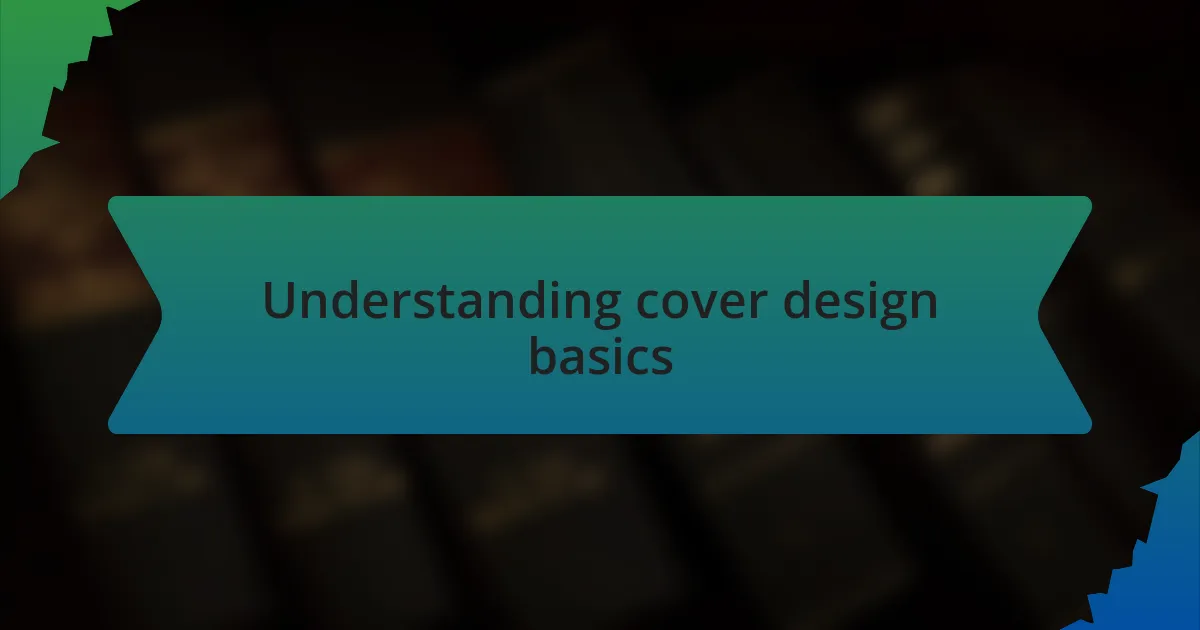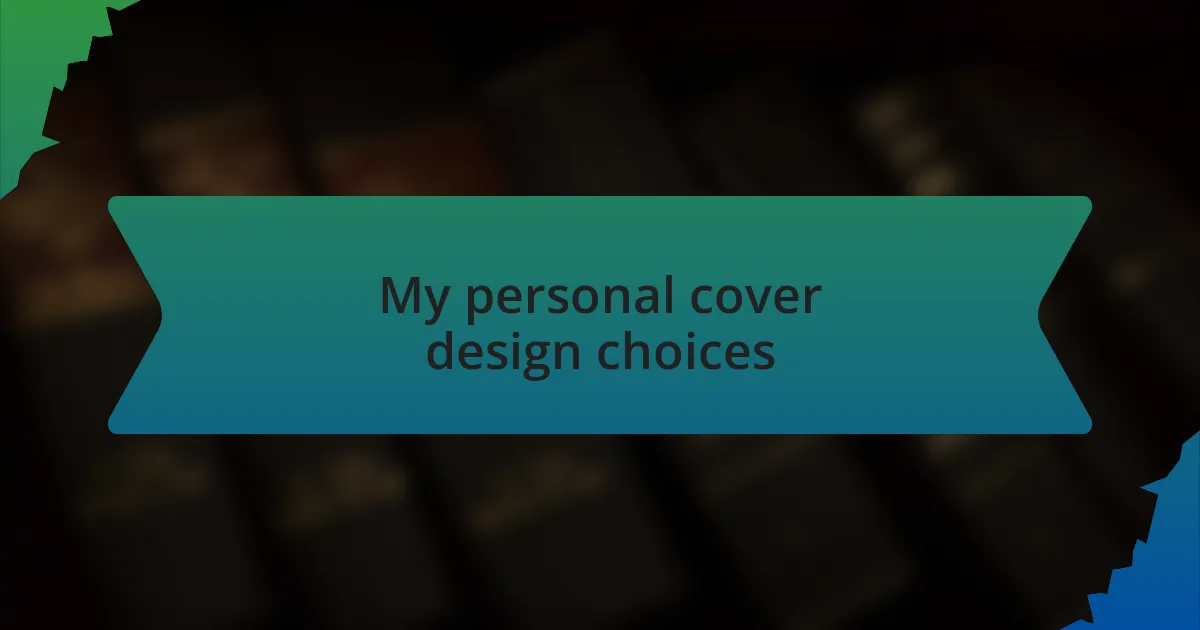Key takeaways:
- Effective cover design balances imagery, color palettes, and typography to resonate with the audience and convey the book’s theme.
- Choosing a design style should reflect the author’s voice while considering current design trends to enhance appeal.
- Feedback and experimentation are crucial in refining cover designs, leading to clarity and emotional connection with readers.
- Consistency in cover design across titles helps establish a recognizable brand identity, crucial for attracting the right audience.

Understanding cover design basics
Cover design is a fascinating blend of art and psychology. I remember designing my first book cover, feeling both excited and overwhelmed. What colors capture the essence of my story? What images resonate with potential readers? These questions kept swirling in my mind, reflecting the challenge of ensuring that the cover communicates the theme and mood of the book effectively.
Understanding the basics of cover design involves knowing who your audience is and what appeals to them. For instance, I’ve learned that a thriller might need bold colors and sharp fonts to convey urgency, while a romance novel could benefit from softer tones and flowing scripts. This realization made me appreciate how visual elements can evoke emotions even before the first page is turned.
Typography is another critical element that often gets overlooked. The fonts we choose can set the tone and create a connection with the reader. I’ve experienced firsthand how a well-selected typeface can transform a cover from mundane to captivating. Have you ever picked up a book simply because the title was striking? That’s the power of thoughtful design in action.

Elements of effective cover design
One of the most impactful elements of effective cover design is imagery. I recall a time when I was drawn to a book solely because of its cover art. The powerful imagery not only intrigued me but also hinted at the adventures within. It made me wonder: how does a single image capture an entire narrative? This illustrates the importance of selecting visuals that reflect the core theme, setting the stage for the reader’s experience.
Color palette selection plays a pivotal role in conveying mood and genre. During my journey into independent publishing, I discovered that warm tones often evoke feelings of comfort and nostalgia, whereas cooler tones can create a sense of suspense or introspection. I vividly remember changing a design from bright, cheerful colors to a darker scheme when the story took a surprising turn. This change was essential in aligning the cover with the emotional journey of the book.
Finally, simplicity often reigns supreme in effective cover design. I once tried to incorporate every idea I had into a single cover, only to realize it felt cluttered and confusing. Stripping back unnecessary elements allowed the core message to shine through. It made me reflect on how a clean design can invite curiosity and clarity, ultimately drawing readers in rather than overwhelming them. Does your cover convey the essence of your story in its simplest form?

Choosing the right design style
When it comes to choosing the right design style, it’s crucial to consider your target audience. I remember grappling with whether a minimalist style would resonate with my readers or if a more intricate design would capture their attention. Ultimately, designing with the reader in mind not only helps create a connection but also sets the tone for the entire reading experience. What resonates with your audience?
Another important aspect is to embrace your unique voice as a creator. I once opted for a whimsical style that felt natural to me, reflecting my quirky storytelling approach. It turned out to be a lovely fit, inviting readers who appreciated that particular charm. When selecting a design style, ask yourself: how does your personal flair influence the choices you make?
Finally, staying informed about design trends can help in selecting a style that feels current yet timeless. I recall revisiting a project and realizing it looked dated against evolving aesthetics. By incorporating modern elements while staying true to my narrative, I was able to refresh the design without losing my story’s essence. How can blending trend awareness with authenticity enhance your cover design?

Analyzing successful cover designs
Successful cover designs often stem from a clear understanding of the book’s theme. I recall working on a project where the cover initially showcased vibrant colors and busy imagery. However, after revisiting the central message of the book, I shifted to a serene, monochromatic palette that perfectly echoed its introspective nature. Have you ever noticed how a cover can instantly evoke emotion simply by aligning with the story’s essence?
Another critical element is the balance between visual appeal and information. During one of my earlier self-publishing endeavors, I struggled to include every detail about the plot on the cover. In the end, I learned that a captivating image combined with a well-placed title often sparked curiosity far better than overwhelming potential readers with text. Isn’t it interesting how sometimes less truly is more?
Moreover, paying attention to typography can significantly influence a cover’s success. I experimented with various fonts for one of my novels and discovered that a unique typeface could convey a genre’s tone at a glance. For instance, a handwritten style worked wonders for a heartfelt memoir, creating a personal connection before someone even opened the book. How do you think the right font can transform the initial impression of your cover design?

My personal cover design choices
My personal cover design choices often reflect my own creative journey. For one of my poetry collections, I chose a simple yet impactful image—a solitary tree under a starry sky. It resonated with me because it symbolized solitude and introspection, themes deeply woven into my poems. When I shared this cover with friends, their emotional reactions affirmed my belief that visuals could resonate powerfully with readers.
I’ve also found that color choices play a crucial role in setting the mood for my books. While working on a thriller, I instinctively leaned toward dark hues like deep blue and black, which created an atmosphere of suspense. Interestingly, I noticed that these colors not only captured the essence of the story but also attracted the right audience—readers who gravitate toward darker themes. Have you ever wondered how much the color scheme of a cover can influence a reader’s first impression?
When it comes to typography, I have a personal rule: the font must complement the story without overshadowing it. I remember designing the cover for a children’s book where I opted for playful, rounded letters that mirrored the whimsical nature of the tale. Not only did this choice attract young readers’ eyes, but it also conveyed a sense of joy and lightheartedness. Isn’t it fascinating how such seemingly small elements can have a profound impact on overall design?

Lessons learned from my experiences
I’ve learned that feedback is essential in the cover design process. When I initially shared my draft for a memoir cover, a close friend pointed out that it felt too cluttered. At first, I was a bit defensive, but their perspective allowed me to trim down unnecessary elements, resulting in a cleaner design that truly focused on my story. Have you ever been surprised by how an outside opinion can refine your vision?
Another important lesson is to trust your instincts while being open to experimentation. I once played with a minimalist approach for a science fiction novel, using just a single, striking image against a bold color. The risk paid off; readers appreciated the unique design and how it spoke to the genre’s essence. It reminded me that sometimes simplicity can leave the most lasting impression. Have you ever taken a leap of faith with a design that made you second-guess yourself?
I’ve also come to appreciate the importance of consistency across my titles. When I realized that my book covers had varying styles, I knew it could confuse potential readers about the genre and tone. By applying a cohesive look, I established a recognizable brand that resonates with my audience. It’s curious how people are drawn to familiarity, isn’t it? The lesson here is clear: brand identity matters, even in independent publishing.